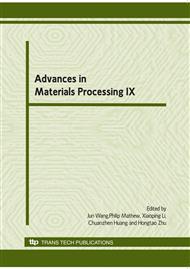p.681
p.687
p.693
p.699
p.705
p.711
p.717
p.723
p.731
Parameter Optimization towards Highest Micro MIM Density by Using Taguchi Method
Abstract:
Nowadays, micro metal injection molding has become among the promising method in powder metallurgy research to produce small-scale intricate part at an effective process and competitive cost for mass production. This paper investigated the optimization of highest green strength which plays an important characteristic in determining the successful of micro MIM. In this paper, stainless steel SS 316L with D50 = 5.96µm was used with composite binder, which consists of PEG (Polyethelena Glycol), PMMA (Polymethyl Methacrilate) and SA (Stearic Acid). Feedstock with 61.5% with several injection parameters were optimized which highly significant through screening experiment such as injection pressure(A), injection temperature(B), mold temperature(C), injection time(D) and holding time(E). Besides that, interaction effects between injection pressure, injection temperature and mold temperature were also considered to optimize in the Taguchi’s orthogonal array. Analysis of variance (ANOVA) in terms of signal-to-noise ratio (S/N-larger is better) for green density was also presented in this paper. Result shows that interaction between injection temperature and mold temperature(BxC) give highest significant factor followed by interaction between injection pressure and mold temperature(AxC). Single factor that also contributes to significant optimization are mold temperature(C) and injection time(D). This study shows that Taguchi method would be among the best method to solve the problem with minimum number of trials.
Info:
Periodical:
Pages:
705-710
Citation:
Online since:
June 2010
Price:
Сopyright:
© 2010 Trans Tech Publications Ltd. All Rights Reserved
Share:
Citation:


